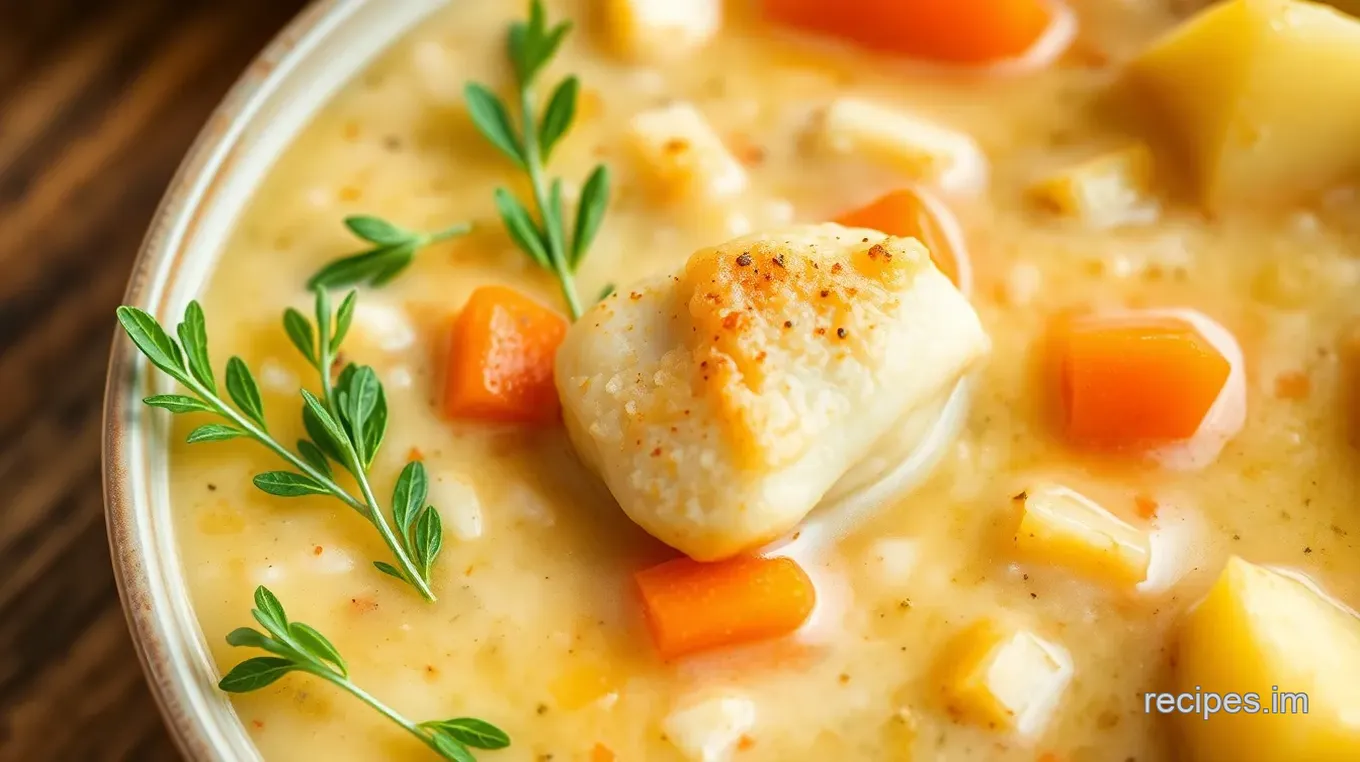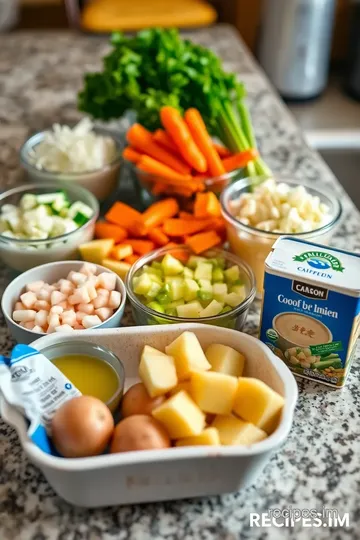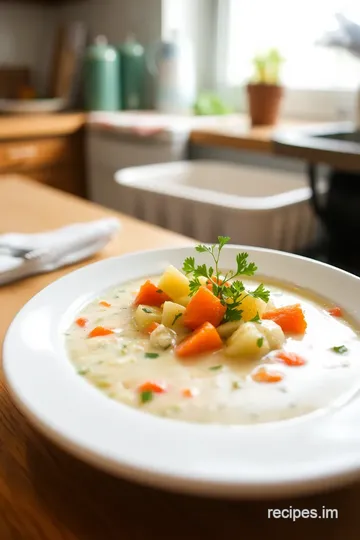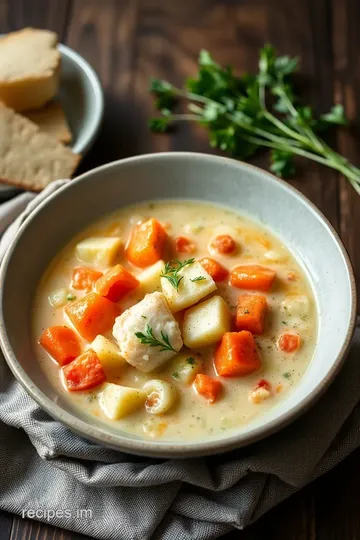Acid Reflux-Friendly Fish Chowder
Discover a soothing acid reflux diet recipe for fish chowder that's creamy, easy to make, and perfect for sensitive stomachs. Try this nourishing dish today!

- The Complete Guide to Authentic Acid Reflux-Friendly Fish Chowder
- The Magic Behind This Recipe
- Health and Nutrition Highlights
- Recipe at a Glance
- Master Ingredient List
- Kitchen Equipment Essentials
- Foolproof Cooking Steps for Acid Reflux-Friendly Fish Chowder
- Game-Changing Tips
- Perfect Presentation
- Storage and Make-Ahead
- Creative Variations
- Complete Nutrition Guide
- Expert FAQ Solutions
- Recipe Card
Have you ever found yourself in the middle of a culinary adventure, only to find out halfway through that your favorite dish doesn’t love your stomach back? yeah, me too! that's why today, i’m excited to share a delightful twist on a classic comfort food that’s not just tasty but also gentle on sensitive stomachs— acid reflux-friendly fish chowder .
This recipe is not only pocket-friendly and quick to whip up—taking just about 40 minutes from start to finish—but also easy enough for a beginner cook to tackle.
Trust me, if i can do it without burning my kitchen down, you can too!
Ah, chowder! that creamy, soul-soothing dish that has warmed hearts and filled bellies for generations. did you know that chowder’s roots can be traced back to the maritime communities of england? it’s believed that fishermen along the coast made a similar stew using whatever they could catch and their trusty cauldron.
Fast forward a few centuries, and we’ve ended up with countless variations, from clam chowder to our fishy delight today.
The thing that really sets our acid reflux diet recipe for fish chowder apart is its mindful approach to ingredients, making sure you don't have to deal with those pesky heartburn flare-ups while still enjoying a rich and hearty meal.
The unique selling point of this chowder is how it embraces both tradition and modern health concerns. made with gentle, non-acidic ingredients, this recipe is perfect for anyone looking for delicious yet digestive-friendly meals .
Who says comfort food has to come with a side of discomfort? you’re in for a treat!
The Complete Guide to Authentic Acid Reflux-Friendly Fish Chowder
Chowder is steeped in culinary heritage, and while many might think of it as a new england staple, its history is rich and diverse.
The blend of flavors—creamy, smooth, and sometimes brimming with fresh herbs—captures the essence of both tradition and home-cooked love. this recipe elevates the classic chowder to something truly special.
We’re not just tossing in any old seafood; we’re using gentle fish protein sources like cod or haddock, making it a comforting dish for everyone, especially those with sensitive stomachs.
This chowder embraces a fascinating origin story that echoes with the laughter and warmth of fishermen’s wives who prepared hearty meals for their families.
In today's fast-paced world, where healthy eating often feels complicated, this dish stands out as a vibrant, nourishing option that’s made it into many kitchens across the globe—this isn't just a meal, it's a cultural celebration!
The Magic Behind This Recipe
One of the things i love most about this acid reflux-friendly chowder is the surprising flavor combinations. the earthy sweetness of the carrots and potatoes meshes beautifully with the delicate flakiness of the fish and the herbaceous notes of thyme.
It’s like a comforting hug from your grandma on a rainy day!
Now, let’s talk about foolproof techniques. i’ve made my fair share of chowders that turn out bland or watery, but i've learned that the trick lies in sautéing the veggies just right and layering in those herbs slowly as the broth simmers.
The whole process is rather forgiving, making it a chance to relax and get in touch with your inner chef.
You might even pick up some spontaneous cooking tips along the way.
Time-saving tips? give me a minute! prepare your veggies ahead of time, and keep your fish frozen until you’re ready to cook.
It helps keep everything fresh while allowing you to whip this up in no time.
Health and Nutrition Highlights
Speaking of being gentle on the gut, let's dive into the health benefits. this chowder is a powerhouse of nutrients! rich in fish protein sources, it’s packed with omega-3 fatty acids, which are great for heart health.
The veggies add a lovely texture and important vitamins, making this a truly balanced meal that matches with many healthy seafood recipes .
For those keeping an eye on dietary considerations, this recipe is also dairy-free and low-sodium—perfect for anyone navigating requirements like an acid reflux diet.
If you’re looking for meals that won’t rock your digestion boat, this dish should certainly be on your radar!
Recipe at a Glance
Here’s a quick snapshot of what you need to know before diving in:
- Total Preparation Time: 15 minutes
- Cooking Time: 25 minutes
- Total Time: 40 minutes
- Skill Level Required: Easy
- Serving Size Details: 4 servings
- Cost Efficiency: Super budget-friendly
Ready to get cooking? Let’s dive into the ingredients you'll need to make this comforting, acid reflux-friendly fish chowder . You won't want to miss the next section—your shopping list is just around the corner!

Master Ingredient List
Premium Core Ingredients
When you're crafting your acid reflux diet recipe for fish chowder , choosing the right core ingredients can make all the difference. Let’s break it down.
-
Olive oil (2 tablespoons) : opt for extra virgin olive oil if you can. it's a chase for quality! check for a rich green color and a fresh, fruity aroma.
Store it in a cool, dark place to keep it from going rancid—believe me, i learned this the hard way!
-
Onion (1 medium, finely chopped) : a good onion should feel firm and heavy, with a papery skin. for flavor balance, try to avoid the super pungent ones.
You can store them in a cool, dark place to keep them lasting longer.
-
Garlic (2 cloves, minced) : now, garlic can easily elevate dishes, but i know some who have to steer clear because of acidity.
If you can handle it, go for fresh, and always store it in a dry place away from light.
-
Carrot (1 medium, diced) and celery (1 stalk, diced) : pick carrots that are vibrant and firm. celery should feel crisp and not wilted.
Both can be kept in the fridge, but for longevity, keep them in a breathable bag.
-
Potatoes (2 medium, peeled and diced) : Look for potatoes that are smooth, without any blemishes. That earthy smell? It’s a good sign! Store them in a cool, dark place, too.
-
Vegetable broth (4 cups, low sodium) : I usually prefer homemade if time allows—just simmer some veggies and herbs! But store-bought is just fine. Go for organic brands if you can.
-
Bay leaf (1) : Opt for whole leaves. They should smell aromatic! Keep them airtight to retain flavor.
-
Thyme (1 teaspoon dried or 1 tablespoon fresh) : Fresh thyme can turn a decent chowder into something heavenly. Always choose fragrant sprigs at the market.
-
Cabbage (1 cup, shredded) : Look for a firm head with crisp leaves. Refrigeration keeps it crunchy!
-
Fish (1 pound) : Fresh fish should smell like the sea, not fishy. Always ask your fishmonger about freshness and keep it cold until you're ready to use it.
-
Non-dairy milk (1 cup) : Almond or oat milk works beautifully here. Choose unsweetened for a neutral flavor! Store it in the fridge after opening.
-
Black pepper : Freshly ground offers the best flavor. But, if you’re cautious about spice, use sparingly.
-
Fresh parsley (2 tablespoons, chopped) : Look for bright green, vibrant leaves. Keep it in the fridge with stems in water, like a bouquet!
Signature Seasoning Blend
Speaking of enhancing flavors, let’s talk about seasoning!
-
Spice combinations : Yes, black pepper, but also think about mild spices like paprika for color without heat.
-
Herb selections : Besides thyme, consider basil or even dill if you're feeling adventurous, especially in the warmer months.
-
Flavor enhancers : Sometimes, a squeeze of lemon can brighten your chowder without adding too much acidity.
-
Aromatic additions : Cinnamon might sound odd, but a pinch can give a twist that elevates the dish!
Smart Substitutions
Don't fret if you can't find the exact ingredients! Here are a few options:
-
Alternative options : Can't locate cod? Haddock or even tilapia works too.
-
Dietary swaps : For non-dairy, coconut milk could add a tropical flair—just balancing the sweetness is key.
-
Emergency replacements : If you're out of broth—water works in a pinch, but add a touch of salt.
-
Seasonal variations : Swap in whatever veggies look fresh and inviting—zucchini, peas, or corn. Embrace the season.
Kitchen Equipment Essentials
Before you dive into cooking, let’s chat tools.
-
Must-have tools : A reliable pot or Dutch oven is a must for this chowder. Trust me—a heavy base distributes heat evenly and prevents burning.
-
Recommended appliances : If you own an immersion blender, it could whip up a luxurious creamy texture, but don’t worry too much if you don't have one.
-
Helpful gadgets : A fish spatula works wonders when flipping or removing fish.
-
Home alternatives : No fancy measuring? Relatable! A standard coffee cup can often stand in for a measuring cup in a pinch.
Pro Ingredient Tips
Let me share some nuggets of wisdom I've picked up along the way:
-
Selection secrets : Always trust your nose! A fresh ingredient often has a distinct aroma.
-
Quality markers : For fish, look for clear eyes and shiny skin.
-
Storage solutions : Always wrap leftover veggies properly to avoid wilting. A damp paper towel can extend their life.
-
Money-saving tips : Buy in bulk when possible. Frozen fish can be a lifesaver for quick meals.
Now that we have our ingredients sorted like a neatly stacked pantry, let’s move on to the fun part—cooking! Ready to create something nourishing? I can almost smell that chowder wafting through the kitchen!
Foolproof Cooking Steps for Acid Reflux-Friendly Fish Chowder
When it comes to whipping up a comforting bowl of chowder that won't upset your stomach, i'm all in. the acid reflux diet recipe for fish chowder has become a staple in my kitchen; it’s hearty, delicious, and hey, it’s got a friendly touch for those sensitive stomachs among us.
Let’s dive into the nitty-gritty of how to make this chowder a success every time!
Essential Preparation Steps
Before diving into the cooking mayhem, let's prep like pros. this is where mise en place comes into play. get everything ready: chop your onion, dice the veggies, and cube your fish.
I remember the first time i made chowder without setting things up. i was rummaging through my pantry while the pot boiled over—what a mess! so, trust me, prep first!
-
Time Management : It takes about 15 minutes to prep. During this time, you can heat your pot! Killing two birds with one stone, right?
-
Organization tips : place your ingredients in little bowls or groups on the counter. this way, when it’s time to throw everything in, you won't be scrambling around like i did that one fateful evening.
Professional Cooking Method
Now, let’s get that chowder rolling! Follow this step-by-step process for a result that’ll have your family asking for seconds.
-
Heat Oil : Firstly, heat 2 tablespoons of olive oil over medium heat in a large pot.
-
Sauté Vegetables : Time to toss in the finely chopped onion. Cook it until it’s translucent, about 3-4 minutes. If you opt to add garlic, toss it in at the last minute—just be careful; I’ve burned garlic before, and boy, it’s not fun!
-
Add Root Vegetables : Stir in the diced carrot, celery, and potatoes. Let this mix cook for about 5 minutes, stirring occasionally. You’ll want them slightly softened but not mushy.
-
Combine broth and herbs : pour in 4 cups of low-sodium vegetable broth. it not only adds flavor but keeps it gentle on your stomach.
Toss in the bay leaf and thyme, bring this to a boil, then reduce the heat to let it simmer for a solid 10 minutes until the veggies start to soften.
-
Add cabbage and fish : now, stir in the shredded cabbage and gently fold in your fish chunks. simmer for another 5-7 minutes until the fish flakes easily with a fork.
No one likes chewy fish; trust me on this.
-
Add Milk : Remove the chowder from the heat and stir in a cup of non-dairy milk. At this point, I like to taste and see if I need a touch of black pepper—but remember, go easy if you're sensitive!
-
Serve : Finally, scoop that beautiful chowder into bowls and sprinkle fresh parsley on top. Feast your eyes on this masterpiece!
Expert Techniques
Let’s level up our chowder game with a few expert techniques!
-
Critical steps : ensure not to overcrowd the pot with fish; it should have space to cook properly. if you’re using frozen fish, let it thaw before mixing it in to avoid excess moisture.
-
Precision Points : Keep an eye on the temperature! If it’s too hot, you’ll end up with overcooked fish.
-
Quality Checks : Always taste before serving—this is key. You want your flavors to pop, but still be gentle enough for those with acid reflux issues.
Success Strategies
Okay, so you’ve followed the steps, but what if things don't turn out as planned? Don’t fret!
-
Troubleshooting tips : if your chowder seems too thin, you can mash some potatoes against the pot’s edge to thicken it naturally.
If it tastes a little bland, maybe you forgot the bay leaf—don’t sweat it! just add a tad more seasoning.
-
Perfect Results Guide : The fish should be perfectly flaky and the veggies tender yet firm. If you see mush—yikes! We overcooked it!
Making this fish chowder should be a fun and rewarding experience, and honestly, it’s a meal my whole family can enjoy, even the ones who usually shy away from seafood! Keep in mind, recipes are often forgiving—let your own flair come through!
The next section will discuss some variations you can make on this recipe, plus suggestions for delightful side dishes. So, stay tuned for those extra tasty tips!

Game-Changing Tips
When it comes to making an acid reflux diet recipe for fish chowder , having a few game-changing tips can really elevate your cooking experience.
First off, don't skip out on professional insights from chefs who've been through the ringer (trust me, i've had my share of kitchen flubs).
Using low-sodium vegetable broth really makes a difference, preserving flavor without that pesky salt overload that could upset your stomach.
Expert techniques come in handy, especially when dealing with fish. i learned the hard way that overcooking it can leave your chowder tasting like soggy cardboard.
Instead, aim for perfectly tender pieces of fish that flake easily but are still moist. and here's a little kitchen wisdom : whenever using herbs like thyme, fresh is usually better.
But if fresh isn't available, dried herbs work just fine in a pinch. and a quick tip for a success guarantee ? keep your ingredients as fresh as possible—nothing beats that pop of flavor.
Perfect Presentation
Okay, so you’ve whipped up a delicious fish chowder, but how do you make it look as good as it tastes? plating techniques are key here.
Use a wide-lipped bowl and ladle the chowder in gently, letting it pool in the center.
Next, let’s talk about garnish ideas . a sprinkle of fresh parsley not only adds color but also hints at freshness.
Sliced lemon on the side can catch the eye and provide an extra squeeze of zesty goodness for those brave enough to handle acidity.
Plus, why not pair it with some crunchy whole grain crackers ? this gives texture and is one of my favorite serving suggestions !
And don’t forget about those visual appeal tips —a drizzle of non-dairy milk swirled on top right before serving adds a lovely creamy element that’s as pretty as it is delicious.
Storage and Make-Ahead
Sometimes, life is a whirlwind, right? that’s where storage guidelines come in. if you make a big pot of that chowder, store it in an airtight container in the fridge for up to three days.
If you still have leftover chowder, preservation methods become important. thin it with a bit of broth before freezing to avoid that awkward thickening situation i once experienced.
Yikes!
When you're ready to dig into your delicious creation, the reheating instructions are simple: just warm it gently on the stovetop, stirring occasionally.
That preserves the fish’s texture. and freshness tips ? well, consider adding a fresh sprinkle of herbs just before serving to keep it lively.
Creative Variations
Adding a personal touch can really make a difference with chowder. changing flavors or adapting for dietary needs opens a door to creativity.
For instance, one winter i added seasonal twists like sweet potatoes for a heartier texture—new favorite established! if you’re feeling adventurous, try a bit of coconut milk instead of non-dairy milk for a creamy tropical flair.
You can also tweak those dietary modifications based on what suits you best. going gluten-free ? just make sure your broth doesn’t contain any gluten, and you're golden.
And don’t shy away from regional variations —imagine a chowder inspired by new england with clams instead of fish for a unique chowder experience.
Complete Nutrition Guide
With the growing focus on health, knowing what you’re consuming can really enhance your dining experience. this chowder not only tastes good but is also quite satisfying.
The detailed breakdown reveals about 230 calories and 20g of protein per serving, making it a great choice for nourishing recipes for reflux sufferers .
Among the health benefits , it's rich in omega-3 fatty acids from the fish, which is a plus for heart health.
The use of non-acidic ingredients and loads of veggies offers plenty of fiber too, contributing to that happy stomach vibe.
That said, before you dig in, get familiar with the dietary information for your specific needs, and it wouldn’t hurt to follow the portion guidance to ensure it fits your daily goals.
Expert FAQ Solutions
Even after all my chowder-making experience, questions still pop up . one common concern is how to truly make it gentle on the stomach.
An expert answer i’ve learned over time is to avoid heavy spices and keep the mild seasoning for heartburn at the forefront of your cooking.
Have a few troubleshooting tips? sure! if your chowder ends up too salty or thick, just add a splash more non-dairy milk or broth.
That usually does the trick. and a little success tip ? keep it simple. sometimes, it’s the straightforward approach that hits the spot.
Every time i make this chowder, i’m reminded of cozy dinners spent together. cooking is such a personal thing, and sharing it makes it all the better.
Embrace those moments, try this recipe, and don’t hesitate to get creative. enjoy!

Acid Reflux-Friendly Fish Chowder Card

⚖️ Ingredients:
- 2 tablespoons olive oil
- 1 medium onion, finely chopped
- 2 cloves garlic, minced (optional)
- 1 medium carrot, diced
- 1 stalk celery, diced
- 2 medium potatoes, peeled and diced
- 4 cups vegetable broth (low sodium)
- 1 bay leaf
- 1 teaspoon thyme (dried or 1 tablespoon fresh)
- 1 cup cabbage, shredded
- 1 pound fish (such as cod or haddock), skinless and boneless, cut into chunks
- 1 cup non-dairy milk (such as almond or oat milk)
- Black pepper, to taste (optional)
- 2 tablespoons fresh parsley, chopped (for garnish)
🥄 Instructions:
- Step 1: In a large pot, heat the olive oil over medium heat.
- Step 2: Add the chopped onion and cook until translucent, about 3-4 minutes. If using garlic, add it in the last minute of sautéing.
- Step 3: Stir in the diced carrot, celery, and potatoes. Cook for an additional 5 minutes, stirring occasionally.
- Step 4: Pour in the vegetable broth and add the bay leaf and thyme. Bring the mixture to a boil, then reduce the heat and let it simmer for 10 minutes until the vegetables are tender.
- Step 5: Stir in the shredded cabbage and gently add the fish chunks. Simmer for another 5-7 minutes, or until the fish is cooked through and flakes easily with a fork.
- Step 6: Remove the pot from heat and stir in the non-dairy milk. Taste and adjust seasoning with black pepper if desired. Remove the bay leaf before serving.
- Step 7: Ladle the chowder into bowls and garnish with fresh parsley.
Previous Recipe: Cozy Nutmeg-Infused Waffles: Discover 7 Easy Tips for a Delicious Breakfast!
Next Recipe: Zuppa del Giorno Soup: Discover 7 Hearty Italian Recipes
